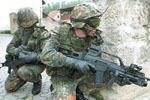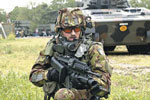Infantry Transformation Gains Momentum
 |
| The Warrior 21 ensemble is an updated version of the EADS-manufactured Infanterist der Zukunft ensemble used by the German army. The kit is designed for export and is currently nearing production and deployment by the Swiss and Spanish armies. |
European armies are networking their infantry. Driven by the need for network-centric forces capable of operating in multinational environments, the continent’s ground forces are pushing their information systems down to the individual soldier. But while these modernization programs are underway, nations and companies are taking different approaches to developing and marketing this new equipment.
Two examples of how
According to Helmut Huegle, head of joint systems and Warrior 21 development for EADS,
Besides having the ability to quickly modify the system for different missions, the kit can be altered to support a specific soldier’s specialty, such as rifleman, commander or sniper. Warrior 21’s communications system features one radio for inter- and intra-squad communications. Huegle notes that most other future soldier projects require two radios per squad. The individual soldier radios also can be used as relays to increase communication range and coverage, thus enhancing tactical flexibility. “We can use the soldier as a relay, as well as the [infantry fighting] vehicle, and we can achieve a communication range of 10 kilometers and more,” he says.
The new kit also includes an indoor navigation system. Known as the DRM module, this device tracks soldiers’ indoor movement and motion. Huegle explains that the module is not reliant on Global Positioning System (GPS) satellite data. When GPS signals are unavailable, either through jamming or when soldiers operate in buildings and caves, the DRM system continues to provide location data.
Interoperability is another key aspect of Warrior 21. It is designed to connect to higher-echelon command, control, communications, computers and intelligence systems. To facilitate this battlefield interaction, Huegle says that the individual soldier radios can transmit both voice and data communications.
Whereas IDZ was a squad-based system, Warrior 21 operates at the platoon level. Huegle shares that the Swiss military wanted a system to support platoon-sized and larger units.
Warrior 21 provides platoon commanders with increased command and control capabilities via augmented reality systems such as map overlays and blue force tracking systems to avoid friendly fire. Commanders also have access to logistics support and mission planning tools. He explains that this capability provides more features and functionality than IDZ, but adds that EADS wants to keep the system simple. “We are providing a very sophisticated solution, but we have to really think about also providing a simple solution,” he says.
Enhanced command and control systems include fire prevention and blue force tracking. Commanders can use the command and control applications to allocate supplies and assign missions. Operational functions also can be handed off between personnel. For example, if a squad leader or commander is injured or killed, all of the system’s command functions can be transferred and managed through the unit’s personal soldier computers.
Warrior 21 also features a voice recognition and control system. Voice control is used to manage the kit’s computer and weapons functions. Huegle explains that the voice command system is built into soldiers’ rifles, permitting them to access communications and computer functions without having to take their hands off their weapons.
Each soldier also has a helmet-mounted display with functions such as blue force locations and mission routes. Additional equipment includes night vision systems, and thermal and infrared weapon sights. All of the equipment is linked via a personal Bluetooth wireless network. The kit includes a personal digital assistant-type handheld device to access information. Huegle notes that this data can also be displayed through the helmet-mounted display.
Warrior 21 currently is being developed for use by the Swiss army. Huegle explains that EADS is working out production details with the Swiss Ministry of Defense. The company also is working with the Spanish army to deliver a second prototype ensemble, with a field trial scheduled for mid-2009. He adds that the company will discuss industrialization and production phases with the Spanish government. Both the Swiss and Spanish projects will rely on local electronics firms. Warrior 21 is designed for export; a key part of the system’s industrial plan is using locally built tactical radios and electronics instead of relying on a single supplier. “If we have a contract abroad, we try to involve local companies to make a knowledge transfer, but also to have a good local footprint,” he says.
 |
| The Soldato Futuro program will equip a number of Italian army units by 2014. The equipment will provide Italian soldiers with enhanced communications and situational awareness capabilities. |
Following a more traditional development scheme is
The equipment was developed by a consortium of five companies led by Selex Communications, with parent company Finmeccanica as the prime contractor. Soldato Futuro underwent a technology demonstration phase in 2004. Three prototype ensembles were produced in 2007. Each prototype is in one of three basic configurations: team leader, grenadier or rifleman. The Italian army field-tested the equipment in 2007. The results of these initial trials were used to modify the ensembles for a final series of tests in March 2008.
The equipment is intended to support platoon- and squad-level operations. The kit provides soldiers with a blue force tracking capability and GPS access. Additional equipment includes a night vision system and a personal communications system. The colonel notes that the kit is fully interoperable with the Italian army’s existing command and control systems.
The ensemble’s command and control system runs a handheld computer with a 4-inch touch screen. Squad leaders are equipped with an 8-inch screen. The computer allows soldiers to receive and send text messages. It also can display digital maps, navigation menus and GPS grids. Most of the connecting cables for the ensemble’s electronics are housed in a special vest to minimize loose wiring. Wireless links were minimized to protect the system from jamming.
A night mobility subsystem includes a helmet-mounted eyepiece displaying computer information or light-intensified imagery from a helmet-mounted video camera. A personal wireless connection allows the kit’s computer and equipment to interact with the systems mounted on the soldier’s rifle. A multipurpose sight provides uncooled infrared and a thermal color video camera that can transmit images to squad leaders or upper echelon commanders.
Communications are provided by an intra-squad radio operating at 800 to 900 megahertz. Col. Del Lungo notes that the squad radio only transmits and receives voice communications and still images. Squads are equipped with a broadband radio for connectivity with higher echelons.
Squad leaders and commanders also are equipped with binoculars featuring an embedded target acquisition system. The colonel explains that the binoculars enable soldiers to transmit data and to mark a target. Another new system is the Scorpio rifle-mounted grenade launcher, equipped with a ballistic computer and an integrated laser range finder. The computer can be reconfigured with uploaded firing tables to provide soldiers with exact ballistics for a range of ammunition, which should increase hit probability against moving ground targets. The system also provides the proper elevation to raise the rifle when firing the grenade launcher.
The infantry ensemble is designed to interact with the electronics on a new generation of light infantry fighting vehicles that are entering service. Soldato Futuro is part of a larger program to modernize the Italian army’s tactical units. Col. Del Lungo says that the program’s first phase will integrate all army brigades with datalinks and modern high frequency radios between 2014 and 2019. Similar to mechanized infantry concepts such as IDZ, the vehicle will serve as a node, collecting data from soldiers’ sensors and unmanned robotic platforms and transmitting it to higher echelons.
The colonel notes that the Italian army wants to avoid a locked-in acquisition system that prevents the introduction of new systems and technologies. The government is currently working out its requirements. He adds that, “At the end of the day, the Italian armed forces didn’t want to acquire a system only to find out that it isn’t what they needed.”
Web Resources
EADS: www.eads.net
Swiss Federal Department of Defence, Civil Protection and Sport: www.vbs.admin.ch/internet/vbs/en/home.html
Spanish Ministry of Defense: www.mde.es
Finmeccanica: www.finmeccanica.com
Italian Ministry of Defense: www.difesa.it




Comments